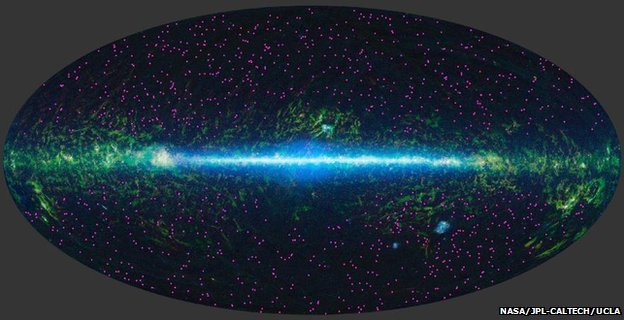Millions of supermassive black holes and hot galaxies spotted by WISE space telescope
NASA’s Wide-Field Infrared Survey Explorer (WISE) space telescope has added to its list of spectacular finds, spotting millions of supermassive black holes and blisteringly hot, “extreme” galaxies.
The finds once lay obscured behind dust.
But WISE can see in wavelengths correlated with heat, seeing for the first time some of the brightest objects in the Universe.
The haul will help astronomers work out how galaxies and black holes form.
It is known that most large galaxies host black holes at their centres, sometimes feeding on nearby gas, dust and stars and sometimes spraying out enough energy to halt star formation altogether.
How the two evolve together has remained a mystery, and the WISE data are already yielding some surprises.

NASA's WISE space telescope has added to its list of spectacular finds, spotting millions of supermassive black holes and hot galaxies
WISE gives astronomers what is currently a unique view on the cosmos, looking at wavelengths of light far beyond those we can see but giving information that we cannot get from wavelengths we can.
Among its other discoveries, in 2011 WISE spotted in a “Trojan” asteroid ahead of the Earth in its orbit.
But with the latest results, WISE has come into its own as an unparalleled black hole hunter.
“We’ve got the black holes cornered,” said Daniel Stern of NASA’s Jet Propulsion Laboratory (JPL), lead author of one of the three studies presented on Wednesday.
Dr. Daniel Stern and his colleagues used the Nuclear Spectroscopic Telescope Array (Nustar) space telescope to examine the X-rays coming out of the black hole candidates spotted by Wise, presenting their findings in a paper to appear in Astrophysical Journal.
“WISE is finding them across the full sky, while Nustar is giving us an entirely new look at their high-energy X-ray light and learning what makes them tick,” he said.
The other two studies presented – one already published in Astrophysical journal and another yet to appear – focussed on extremely hot, bright galaxies that have until now remained hidden: hot dust-obscured galaxies, or hot-Dogs.
There are so far about 1,000 candidate galaxies, some of which can out-shine our Sun by a factor of 100 trillion.
“These dusty, cataclysmically forming galaxies are so rare WISE had to scan the entire sky to find them,” said Peter Eisenhardt of JPL, lead author of the paper describing WISE’s first hot-Dog find.
“We are also seeing evidence that these record-setters may have formed their black holes before the bulk of their stars. The <<eggs>> may have come before the <<chickens>>.”
The data from the WISE mission are made publicly available so that scientists outside the collaboration can also carry out their own studies, so the future will hold a wealth of studies from these extreme and otherwise hidden corners of the Universe.
[youtube U2fWbhv8WxA]
